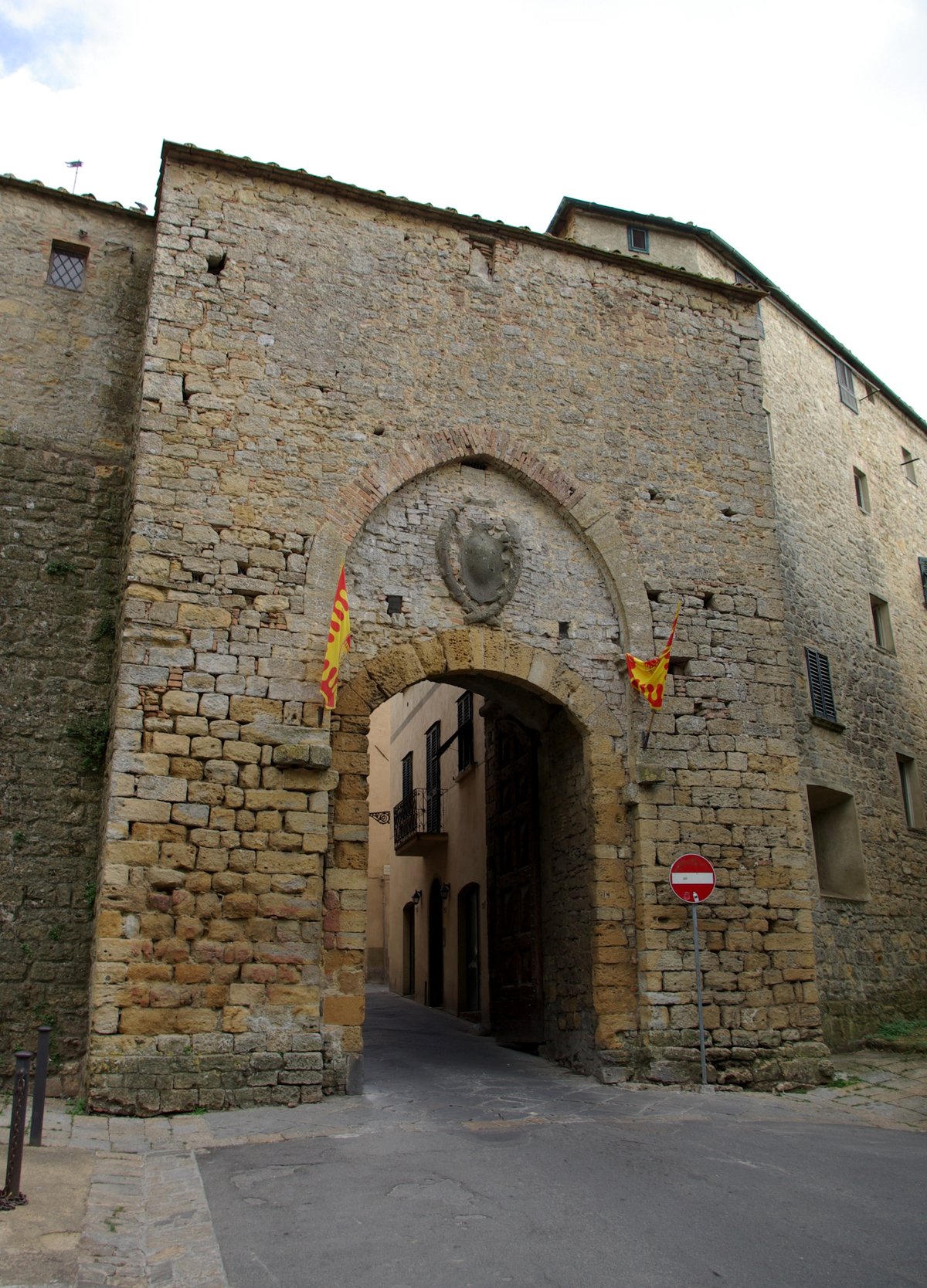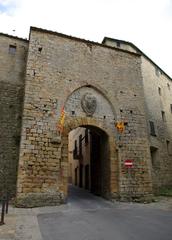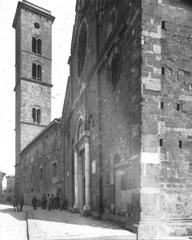
Porta Fiorentina Volterra: Visiting Hours, Tickets, and Travel Guide
Date: 14/06/2025
Introduction
Perched atop a picturesque hill in Tuscany, Volterra is a city where ancient history and vibrant culture converge. Among its most enduring symbols are the medieval gates that once protected and defined the city. Chief among these is Porta Fiorentina—a gateway that not only exemplifies Volterra’s architectural evolution but also embodies its strategic, economic, and cultural significance. Built in the 13th century during a period of urban renewal, Porta Fiorentina replaced earlier Etruscan entrances and reflects the city’s prosperity and changing defensive needs (Discover Volterra; Visit Tuscany).
This guide offers a comprehensive overview of Porta Fiorentina, covering its historical context, architectural features, practical visiting information, and nearby attractions. Whether you’re a history enthusiast, a cultural explorer, or a traveler seeking authentic Tuscan experiences, understanding Porta Fiorentina will enrich your visit to Volterra.
Table of Contents
- Introduction
- Historical Background
- Architectural Features
- Cultural and Symbolic Significance
- Preservation and Current Condition
- Visiting Information
- Exploring Nearby Attractions
- Practical Visitor Tips
- Frequently Asked Questions (FAQs)
- Summary & Travel Tips
- References
Historical Background
Etruscan and Roman Foundations
Volterra, originally known as Velathri, was a significant Etruscan city-state from the 7th to 2nd centuries BCE. The Etruscans constructed a formidable wall circuit over 7 km long, punctuated by monumental gates. These entrances were more than defensive measures; they were imbued with religious and ceremonial importance (World History Encyclopedia). The most famous Etruscan gate, Porta all’Arco, still stands today, featuring sculpted deities above its arch (Wandering Italy).
With the Roman conquest, Volterra (Volaterrae) retained its Etruscan defenses while expanding its infrastructure. Gates such as those preceding Porta Fiorentina allowed for trade and military logistics, connecting the city to the surrounding countryside and notable roads (Explore.com).
Medieval Expansion and Renaissance Modifications
During the Middle Ages, Volterra’s fortifications were reinforced and expanded to address new military threats and increased urban activity. The city’s walls included at least eight principal gates, each oriented toward a significant destination (Discover Volterra). Porta Fiorentina, facing north toward Florence, became a crucial point for commerce and travel. The gate’s name reflects its orientation and its role as a primary access point for those journeying between Volterra and Florence (Move About Italy).
In the Renaissance, the Medici family’s influence brought further modifications. Porta Fiorentina was embellished with the Medici coat of arms above its arch, a visible assertion of Florence’s control over Volterra (Casa Volterra). This emblem remains a prominent feature today.
Architectural Features
Porta Fiorentina is a prime example of Tuscan medieval military architecture. The gate is dominated by a robust, rounded arch built from local stone, designed to withstand assaults and the passage of time (Discover Volterra). Defensive features include thick walls, a limited entry point, and integration into the city’s larger wall system. The Medici coat of arms—carved in stone above the arch—serves both as a decorative and symbolic element, reflecting the gate’s Renaissance history (Casa Volterra).
The gate’s design skillfully balances functionality and aesthetics. While primarily a defensive structure, it also served as a ceremonial entrance, welcoming dignitaries and travelers into Volterra. The use of traditional materials ensures the gate blends harmoniously with the surrounding medieval walls and urban landscape.
Cultural and Symbolic Significance
Porta Fiorentina is more than stone and mortar; it is a living symbol of Volterra’s enduring legacy as a crossroads of cultures. Over centuries, merchants, pilgrims, soldiers, and citizens have passed through this gate, each contributing to the city’s evolving story (Discover Volterra). Today, it remains a primary entrance to the city, serving both functional and symbolic roles.
The Medici emblem above the arch is a reminder of the political and historical currents that shaped Volterra, particularly its integration into the Florentine sphere. The gate often features in local festivals, processions, and historical reenactments, making it an active participant in the city’s cultural life.
Preservation and Condition
Porta Fiorentina has survived remarkably intact thanks to the quality of its original construction and ongoing conservation efforts (Discover Volterra). Preservation initiatives focus on maintaining the gate’s structure and its decorative elements, especially the Medici coat of arms. The surrounding area is carefully managed to enhance both visitor experience and historical authenticity.
Visiting Information
Hours and Tickets
Porta Fiorentina, as an open-air monument, is accessible 24/7 and free to visit. No ticket is required for the gate itself. However, adjacent attractions such as the Roman Theater and the archaeological park have specific opening hours—typically 9:00 AM to 7:00 PM in high season and reduced hours in winter (The Discoveries Of). Tickets for these sites range from €5 to €10 and can be bought onsite or online.
Accessibility and Travel Tips
The area around Porta Fiorentina is generally accessible, though some paths are uneven due to the historic nature of the site. The gate is located on the northern edge of Volterra’s center and serves as a main entry point for those arriving from Florence or the surrounding countryside. Parking is available nearby, and the city is well connected by regional buses (Earth Trekkers).
Wear comfortable shoes for cobblestone streets and mild inclines. Benches and shaded areas are available nearby for rest.
Guided Tours
Guided tours of Volterra often include Porta Fiorentina as part of explorations of the city’s medieval walls and archaeological sites (latoscane.net). Booking in advance is recommended during peak seasons.
Exploring Nearby Attractions
- Roman Theater: Just outside Porta Fiorentina, this 1st-century AD structure is one of Volterra’s highlights. Open daily from March to November, it offers well-preserved seating, stage areas, and panoramic views (The Discoveries Of; Earth Trekkers).
- Etruscan Walls: Adjacent to the gate, sections of the 4th-century BC Etruscan walls can be explored, showcasing the city’s ancient origins (The Tourist Checklist).
- Parco Pubblico del Bastione: This public park, accessible via Porta Fiorentina, offers shaded paths and panoramic views of the Tuscan countryside (Travel in Culture).
- Local Markets and Artisan Shops: A short stroll from the gate leads to artisan alabaster workshops and local markets, where visitors can experience Volterra’s living traditions (Italoamericano).
Practical Visitor Tips
- Best Time to Visit: April to September offers pleasant weather and lively local events. Mornings and late afternoons are ideal for photography and fewer crowds (The Discoveries Of).
- Photography: The gate and nearby park provide excellent photo opportunities, especially during golden hour.
- Dining: Enjoy a picnic near the gate or dine in nearby trattorias serving Tuscan specialties such as truffle pasta and aged cheeses (Visit Tuscany).
- Respect the Monument: Do not climb or deface the gate. Responsible tourism preserves Volterra’s heritage for future generations.
Frequently Asked Questions (FAQs)
Q: What are the visiting hours for Porta Fiorentina?
A: Porta Fiorentina is an outdoor gate accessible 24/7. Nearby sites like the Roman Theater have specific hours.
Q: Is there an entrance fee?
A: No ticket is needed for the gate itself. Fees apply only to adjacent archaeological sites.
Q: Is the site wheelchair accessible?
A: The gate is mostly accessible, but uneven surfaces may present challenges. Consult local resources for detailed accessibility information.
Q: Are guided tours available?
A: Yes, many local operators include Porta Fiorentina in their tours.
Q: What else can I see nearby?
A: The Roman Theater, Etruscan walls, Parco Pubblico del Bastione, and artisan shops are all within walking distance.
Summary & Travel Tips
Porta Fiorentina is not just a gateway through Volterra’s medieval walls—it is a gateway through time. Its sturdy arch and Medici insignia reflect centuries of history, from Etruscan roots to Renaissance grandeur. The gate’s enduring function as a main entrance, its proximity to major attractions, and its accessibility make it a must-see for any visitor to Volterra (Discover Volterra; Move About Italy). Whether you’re drawn by history, architecture, or the allure of Tuscany’s landscapes, Porta Fiorentina offers an open invitation to explore and discover.
For the latest travel information and guided audio tours of Volterra’s historic sites, consider downloading the Audiala app and consulting the city’s official tourist resources.
References
- World History Encyclopedia: Volterra
- Discover Volterra – Porta Fiorentina
- Casa Volterra – 11 Porte di Volterra
- Move About Italy – Volterra: Porte
- Visit Tuscany – 10 Things to Do in Volterra
- The Discoveries Of – Volterra Italy Travel Guide
- Explore.com – Volterra Italy Most Underrated
- Earth Trekkers – Best Things to Do in Volterra Italy
- The Tourist Checklist – Things to Do in Volterra
- Travel in Culture – Visit Volterra Villages in Tuscany
- Italoamericano – Volterra More Than Alabaster
- Latoscane.net – Things to See and Do in Volterra

